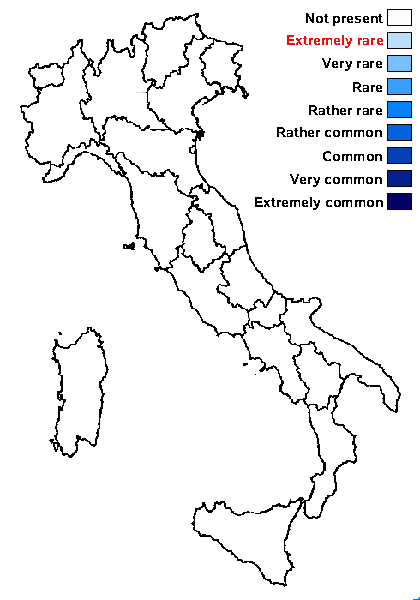Aspicilia adaequata (Lettau) Poelt
Mitt. naturw. Ver. Steiermark 124: 96, 1994.. Basionym: Lecanora adaequata Lettau - Feddes Repert., 59: 21, 1956.
Synonyms:
Distribution:
Description: Thallus crustose, episubstratic, subplacodioid, white-pruinose, thick, the central parts consisting of angular, contiguous areoles, the marginal parts more or less distinctly lobed. Apothecia lecanorine-aspicilioid, immersed to adnate, of irregular shape, with a black, epruinose disc, and a raised, white-pruinose thalline margin. Epithecium brownish green, N+ emerald green; hymenium colourless; paraphyses coherent, submoniliform; hypothecium colourless to yellowish. Asci 8-spored, clavate, the thin outer coat K/I+ blue, the wall and apical dome K/I-. Ascospores 1-celled, hyaline, broadly ellipsoid, 11-19 x 7-10 µm, thin-walled. Photobiont chlorococcoid. Spot tests: cortex of thallus and apothecial margin, and medulla K-, C-, KC-, P-. Chemistry: unknown, probably without lichen substances.Note: a poorly known species recalling A. candida, but marginal lobes less distinct and apothecia with black, epruinose discs. Known from a few localities in the Eastern Alps (Austria), on intermediate rocks, mostly near and above treeline; to be looked for in the Italian Alps.
Growth form: Crustose placodiomorph
Substrata: rocks
Photobiont: green algae other than Trentepohlia
Reproductive strategy: mainly sexual
Poorly known taxon in need of further study

Predictive model
Growth form: Crustose placodiomorph
Substrata: rocks
Photobiont: green algae other than Trentepohlia
Reproductive strategy: mainly sexual
Poorly known taxon in need of further study

Predictive model
 INDEX FUNGORUM
INDEX FUNGORUM
 GBIF
GBIF

